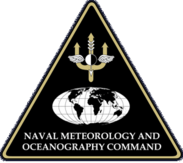- Commander, Naval Meteorology and Oceanography Command
-
Commander, Naval Meteorology and Oceanography Command 
Logo of Naval Meteorology and Oceanography Command Agency overview Formed circa 1970 Preceding agency Depot of Charts and Instruments Jurisdiction Federal government of the United States Headquarters Stennis Space Center, Mississippi Agency executives Rear Admiral Jonathan W. White, Commanding Officer
Edward Gough, Technical Director
Captain John Cousins, Chief of Staff
AGCM Keith Edwards, Master ChiefParent agency United States Fleet Forces Command (USFLTFORCOM) Child agencies Naval Oceanographic Office (NAVOCEANO)
Fleet Numerical Meteorology and Oceanography Center (FNMOC)
Naval Observatory
Naval Oceanography Operations Command
Commander, Undersea Surveillance/Integrated Undersea Surveillance System
Naval Meteorology and Oceanography Professional Development CenterWebsite http://www.navmetoccom.navy.mil The Naval Meteorology and Oceanography Command (COMNAVMETOCCOM) serves as the operational arm of the Naval Oceanography Program. Headquartered at the Stennis Space Center in Mississippi, COMNAVMETOCCOM is a third echelon command reporting to United States Fleet Forces Command (USFLTFORCOM). CNMOC's claimancy is globally distributed, with assets located on larger ships (aircraft carriers, amphibious ships, and command and control ships), shore facilities at fleet concentration areas, and larger production centers in the U.S.
COMNAVMETOCCOM is focused on providing critical environmental knowledge to the warfighting disciplines of Anti-Submarine Warfare; Naval Special Warfare; Mine Warfare; Intelligence, Surveillance and Reconnaissance; and Fleet Operations (Strike and Expeditionary), as well as to the support areas of Maritime Operations, Aviation Operations, Navigation, Precise Time, and Astrometry.
The Oceanographer of the Navy works closely with the staff of COMNAVMETOCCOM to ensure the proper resources are available to meet its mission, to act as a liaison between COMNAVMETOCCOM and the Chief of Naval Operations, and to represent the Naval Oceanography Program in interagency and international forums.
Contents
Mission
It enables the safety, speed and operational effectiveness of our Fleet by illuminating the risks and opportunities for Naval and Joint forces posed by the present and future natural environment.
History
The Naval Meteorology and Oceanography Command traces its ancestry to the Depot of Charts and Instruments, a 19th century repository for nautical charts and navigational equipment. In the 1840s, its superintendent, Lieutenant Matthew Fontaine Maury, created and published a revolutionary series of wind and current charts. This information, still resident in modern computer models of Ocean basins and the atmosphere, laid the foundation for the sciences of oceanography and meteorology.
Atmospheric science was further developed with the birth of naval aviation early in the twentieth century. During World War I and the following decades, naval aerological specialists applied the fledgling concepts of air masses and fronts to warfare and provided forecasts to the first transatlantic flight.
The Navy's weather and ocean programs contributed greatly to Allied victory in World War II. In the Pacific, Navy forecasters cracked the Japanese weather code. Hydrographic survey ships, often under enemy fire, collected data along foreign coastlines for the creation of critical navigation charts.
In the mid-1970s, the Navy's meteorology and oceanography programs were integrated in a single organization reflecting nature's close interaction of sea and air. This structure is today the Naval Meteorology and Oceanography Command.
Organization
Commander, Naval Meteorology and Oceanography Command is a third echelon operational command reporting to Commander, Fleet Forces Command. The Command's personnel are located at its headquarters at the John C. Stennis Space Center near Bay St. Louis, Mississippi, and at several field activities located around the world.
The Command's major subordinate activities include the Naval Oceanographic Office, located at Stennis Space Center Mississippi; Fleet Numerical Meteorology and Oceanography Center, located in Monterey, California; the Naval Observatory, located in Washington, D.C.; the Naval Oceanography Operations Command, located at Stennis Space Center, Mississippi; and the Naval Meteorology and Oceanography Professional Development Center located in Gulfport, Mississippi.
The Command is aligned to and focused on the Navy's five warfighting disciplines – Anti-Submarine Warfare; Special Warfare; Mine Warfare; Intelligence, Surveillance and Reconnaissance; and Fleet Operations (Strike and Expeditionary)-- as well as the following warfighting support disciplines: Navigation, Precise Time and Astrometry, Maritime Operations and Aviation Operations.
References
Source
The source of the information contained in this article is from the official COMNAVMETOCCOM website.
External links
- Commander, Naval Meteorology and Oceanography Command official website
Categories:- United States Navy organization
- United States Navy admirals
Wikimedia Foundation. 2010.

